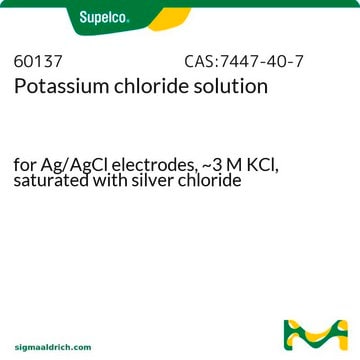449571
Silver chloride
AnhydroBeads™, −10 mesh, 99.998% trace metals basis
Synonym(s):
AgCl (Silver monochloride), Silver(I) chloride
About This Item
Recommended Products
vapor pressure
1 mmHg ( 912 °C)
product line
AnhydroBeads™
assay
99.998% trace metals basis
impurities
≤25.0 ppm Trace Metal Analysis
particle size
−10 mesh
mp
455 °C (lit.)
SMILES string
Cl[Ag]
InChI
1S/Ag.ClH/h;1H/q+1;/p-1
InChI key
HKZLPVFGJNLROG-UHFFFAOYSA-M
Looking for similar products? Visit Product Comparison Guide
Related Categories
Application
Legal Information
signalword
Warning
hcodes
Hazard Classifications
Aquatic Acute 1 - Aquatic Chronic 1 - Met. Corr. 1
Storage Class
8B - Non-combustible corrosive hazardous materials
wgk_germany
WGK 3
flash_point_f
Not applicable
flash_point_c
Not applicable
ppe
Eyeshields, Gloves, type N95 (US)
Certificates of Analysis (COA)
Search for Certificates of Analysis (COA) by entering the products Lot/Batch Number. Lot and Batch Numbers can be found on a product’s label following the words ‘Lot’ or ‘Batch’.
Already Own This Product?
Find documentation for the products that you have recently purchased in the Document Library.
Customers Also Viewed
Articles
Plasmonic nanoparticles have unique optical properties that can be tailored to suit a variety of applications in the biotechnology1–8 and electronics9–16 industries.
Our team of scientists has experience in all areas of research including Life Science, Material Science, Chemical Synthesis, Chromatography, Analytical and many others.
Contact Technical Service












